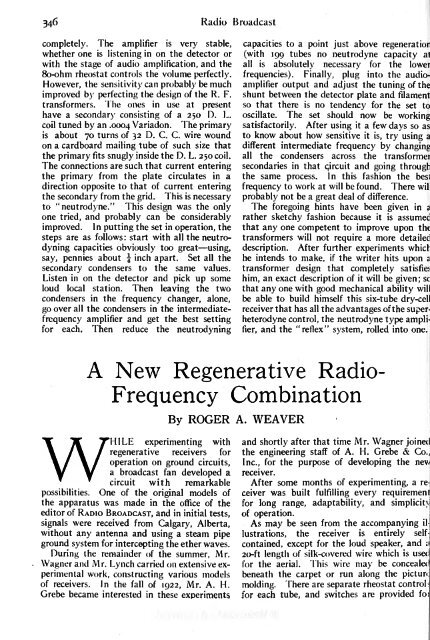Radio Broadcast - 1923, August - 86 Pages, 8.5 ... - VacuumTubeEra
Radio Broadcast - 1923, August - 86 Pages, 8.5 ... - VacuumTubeEra
Radio Broadcast - 1923, August - 86 Pages, 8.5 ... - VacuumTubeEra
- No tags were found...
Create successful ePaper yourself
Turn your PDF publications into a flip-book with our unique Google optimized e-Paper software.
346 <strong>Radio</strong> <strong>Broadcast</strong>completely. The amplifieris very stable,whether one islistening in on the detector orwith the stage of audio amplification, and the8o-ohm rheostat controls the volume perfectly.However, the sensitivity can probably be muchimproved by perfecting the design of the R. F.transformers. The ones in use at presenthave a secondary consisting of a 250 D. L.coil tuned by an .0004 Variadon. The primaryis about 70 turns of 32 D. C. C. wire woundon a cardboard mailing tube of such size thatthe primary fits snugly inside the D. L. 250 coil.The connections are such that current enteringthe primary from the plate circulates in adirection opposite to that of current enteringthe secondary from the grid. This isnecessaryto "neutrodyne." This design was the onlyone tried, and probably can be considerablyimproved. In putting the set in operation, thesteps are as follows: start with all the neutrodyningcapacities obviously too great using,say, pennies about ^ inch apart. Set all thesecondary condensers to the same values.Listen in on the detector and pick up someloud local station. Then leaving the twocondensers in the frequency changer, alone,go over all the condensers in the intermediatefrequencyamplifier and get the best settingfor each. Then reduce the neutrodyningcapacities to a point just above regeneration(with 199 tubes no neutrodyne capacity a1all isabsolutely necessary for the lowerfrequencies). Finally, plug into the audioamplifieroutput and adjust the tuning of theshunt between the detector plate and filamentso that there is no tendency for the set tooscillate. The set should now be workingsatisfactorily. After usingit a few days so asto know about how sensitive it is, try using adifferent intermediate frequency by changingall the condensers across the transformersecondaries in that Circuit and going throughthe same process. In this fashion the beslfrequency to work at will be found. There wilprobably not be a great deal of difference.The foregoing hints have been given in arather sketchy fashion because it is assumedthat any one competent to improve upon thetransformers will not require a more detaileddescription. After further experiments whichhe intends make, if the writer hits iupon totransformer design that completely satisfieshim, an exact description of it will be given; scthat any one with good mechanical ability willbe able to build himself this six-tube dry-cellreceiver that has all the advantages of the superheterodynecontrol, the neutrodyne type amplifier,and the "reflex" system, rolled into one.A New Regenerative <strong>Radio</strong>Frequency CombinationBy ROGER A. WEAVERWHILEexperimenting withregenerative receivers foroperation on ground circuits,a broadcast fan developed acircuit with remarkablepossibilities. One of the original models ofthe apparatus was made in the office of theeditor of RADIO BROADCAST, and in initial tests,signals were received from Calgary, Alberta,without any antenna and using a steam pipeground system for intercepting the ether waves.During the remainder of the summer, Mr.Wagner and Mr. Lynch carried on extensive experimentalwork, constructing various modelsof receivers. In the fall of 1922, Mr. A. H.Grebe became interested in these experimentsand shortly after that time Mr. Wagner joinedthe engineering staff of A. H. Grebe & Co.,Inc., for the purpose of developing the nev/receiver.Aftersome months of experimenting, a receiverwas built fulfilling every requirementfor long range, adaptability, and simplicityof operation.As may be seen from the accompanying illustrations, the receiver is entirely selfcontained, except for the loud speaker, and ;20-ft length of silk-covered wire which is usetfor the aerial. This wire may be concealecbeneath the carpet or run along the pictun-molding. There are separate rheostat controlfor each tube, and switches are provided fot
















